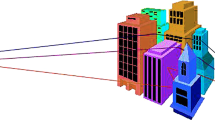Abstract
In the paper, a kind of channel noise produced by nodes accessing channel was considered, and this noise was compared with Middleton Class-A noise. It was assumed that the time, space, frequency of channel accessed by nodes were randomized, hence the channel selection can be described as a random matrix. And the random matrix were approximately calculated and analyzed by Krylov subspace method and matrix integral method. Results of simulation and experiment show, the higher channel accessed rate make the lower package receiving probability in Rayleigh channel; and although the capacity of channel is increased with the access number of nodes, it holds at a limited value when the number is large enough. Results also prove the higher density of sensor nodes make the lower package receiving probability.







Similar content being viewed by others
References
L. Angrisani, M. Vadursi, Cross-layer measurements for a comprehensive characterization of wireless networks in the presence of interference, IEEE Transactions on Instrumentation and Measurement, vol. 56, no. 4, pp. 1148–1156, August 2007.
L. Tang, K.-C. Wang, Y. Huang, and F. Gu, Channel characterization and link quality assessment of IEEE 802.15.4-compliant radio for factory environments, IEEE Transactions on Industrial Informatics, vol. 3, no. 2, pp. 99–110, May 2007.
M. Bertocco, G. Gamba, A. Sona, and S. Vitturi, Experimental characterization of wireless sensor networks for industrial applications, IEEE Transactions on Instrumentation and Measurement, vol. 57, no. 8, pp. 1537–1546, August 2008.
L. Chang, F. Wang,Blind SNR estimation in non-cooperative communications, Journal on Communications, pp. 76–81, 2008.
Y. Sun, X. Wang. Jamming Attacks in Wireless Network. Journal of Software, 23(5): pp. 1207–1221, 2012.
Xu WY, Trappe W, Zhang YY, Wood T. The feasibility of launching and detecting jamming attacks in wireless networks. In: Proc.of the ACM MobiHoc 2005. 2005. 46–57
M. Strasser, B. Danev, S. apkun. Detection of reactive jamming in sensor networks. ACM Trans. on Sensor Networks. 7(2): pp. 1–29, 2010.
A. Mishra, K. Nadkarni, A. Patcha. Intrusion detection in wireless ad hoc networks. IEEE Wireless Communications. 11(1): pp. 48–60, 2004.
K. J. Park, T. R. Park, C. D. Schmitz and L. Sha. Design of Robust Adaptive Frequency Hopping for Wireless Medical Telemetry Systems, IET Commun. doi:10.1049/iet-com.2008.0693, 2008.
S. Y. Shin, H. S. Park, S. C. Choi, and W. H. Kwon. Packet error rate analysis of IEEE 802.15.4 under IEEE 802.11b interference. In Proc.WWIC, pp. 279–288, 2005.
R. Prasad, C. Dovrolis, M. Murray, K. Claffy. Bandwidth Estimation: Metrics, Measurement Techniques and Tools. IEEE Networks, 17(6), pp. 27–35, 2003.
G. Bauch, N. Al-Dhahir. Reduced-Complexity Space-Time Turbo- Equalization for Frequency-Selective MIMO Channels. IEEE Transactions on Wireless Communications, 1(4), pp. 819–828, 2002.
G. Dietl, P. Breun, and W. Utschick.Block Krylov Methods in Time-Dispersive MIMO Systems. In Proceedings of the 2004 IEEE International Conference on Communications, 5, pp. 2683–2688, 2004.
Y. Wan, Q. Wang, S. Duan and X. Zhang. RAFH: Reliable Aware Frequency Hopping Method for Industrial Wireless Sensor Networks, IEEE Wireless Communications, Networking and Mobile Computing (Wicom09),1–4, 2009.
C. Du, X. Wang and L Ma. A Scheme of Optimal Channel Selection with Channel Evaluation for WSNs. International Journal of Future Generation Communication and Networking, 6(2), pp. 147–154, 2013.
J. Zhao, H. Zheng and G. H. Yang. Distributed Coordination in Dynamic Spectrum Allocation Networks. Proc. of IEEE DySPAN 2005, pp. 259–268, 2005.
C.N. Chuah, D. Tse, J.M. Kahn, R.A. Valenzuela. Capacity scaling in MIMO wireless systems under correlated fading. IEEE Trans. on Information Theory, 48, pp. 637–650, 2002.
D. S. Shiu, G. F. Foschini, M. G. Gans, J. M. Kahn. Fading correlation and its effect on the capacity of multielement antenna systems. IEEE Trans. on Communications, 48, pp. 502–513, 2000.
P. Hande, L. Tong and A. Swami, Channel Estimation for Frequency Hopping systems IEEE 1999
N. Baldo, A. Asterjadhi, M. Zorzi. Dynamic Spectrum Access Using a Network Coded Cognitive Control Channel. IEEE Transactions on Wireless Communications, vol. 9(8), pp. 2575–2587, 2010.
A. M. Tulino, S. Verdu.Random matrix theory and wireless communications. Foundations and Trends in Commun. Inf. Theory, vol. 1(1), pp. 1–182, 2004.
J. Wagner, B. Rankov, A. Wittneben. Large n analysis of amplify-and-forward MIMO relay channels with correlated Rayleigh fading.IEEE Trans. Inf. Theory, vol. 54(12), pp. 5735–5746, 2008.
N. Fawaz, K. Zari, M. Debbah, D. Gesbert. Asymptotic capacity and optimal precoding in MIMO multi-hop relay networks. IEEE Trans. Inf. Theory, vol. 57(4), pp. 2050–2069, 2011.
O.Ryan, M. Debbah. Asymptotic behavior of random Vandermonde matrices with entries on the unit circle. IEEE Trans. Inf. Theory, vol. 55(7), pp. 3115–3147, 2009.
R. Couillet, M. Debbah. Random matrix methods for wireless communications. 1st. New York, NY, USA: Cambridge University Press, 2011.
A. L. Moustakas, S. H. Simon, A. M. Sengupta. MIMO capacity through correlated channels in the presence of correlated interferers and noise: A (not so) large n analysis. IEEE Trans. Inf. Theory, vol. 49(10), pp. 2545–2561, 2003.
J. Dumont, W. Hachem, S. Lasaulce, P. Loubaton, J. Najim. On the capacity achieving covariance matrix for Rician MIMO channels: An asymptotic approach. IEEE Trans. Inf. Theory, vol. 56(3), pp. 1048–1069. 2010.
M. Debbah, J. Hoydis. Random Matrix Theory for Advanced Communication Systems. WCNC 2012.
T. Ratnarajah, R. Vaillancourt, M. Alvo. Complex Random Matrices and Rayleigh Channel Capacity. Communications in Information or Systems, 2003
D. Middleton. Non-Gaussian Noise Models in Signal Processing for Telecommunications: New Methods and Results for Class A and Class B Noise Models. IEEE Transactions of information theory,45(4): 1129–1149, 1999.
R. Weiss. A theoretical overview of Krylov subspace methods, Applied Numerical Mathematics. vol 19, 207–233,1995.
Acknowledgments
This work is supported by China–Canada joint research and development projects under Grant No. 2009DFA12100, major Project of Sichuan Provincial Department of Education No. 14ZA0172 and No. 13ZB0082.
Author information
Authors and Affiliations
Corresponding author
Rights and permissions
About this article
Cite this article
Deng, C. Channel Selection and Access Density Analysis Based on Random Matrix in WSN. Int J Wireless Inf Networks 22, 171–179 (2015). https://doi.org/10.1007/s10776-015-0274-z
Received:
Accepted:
Published:
Issue Date:
DOI: https://doi.org/10.1007/s10776-015-0274-z




